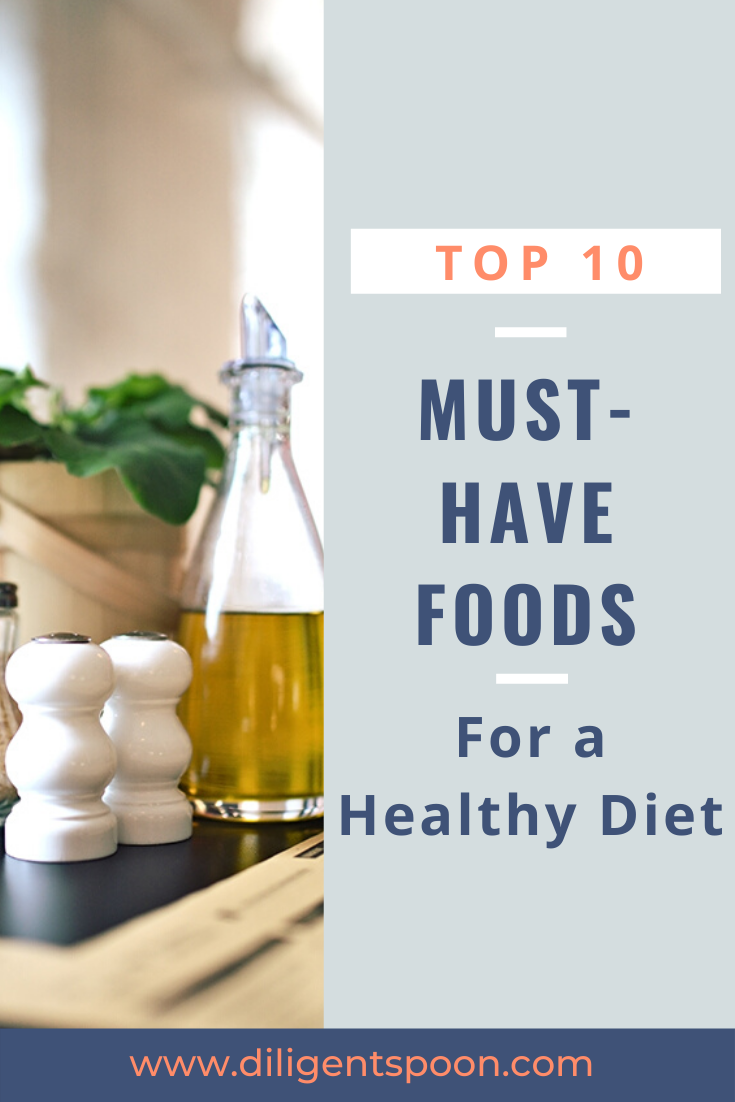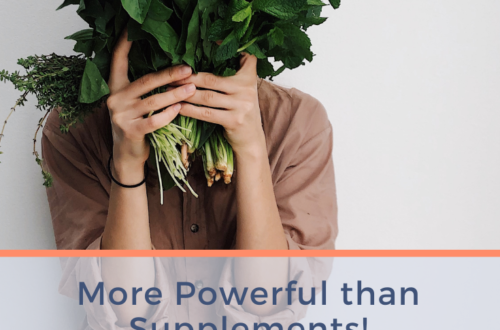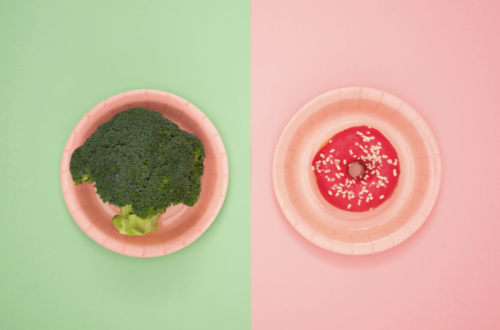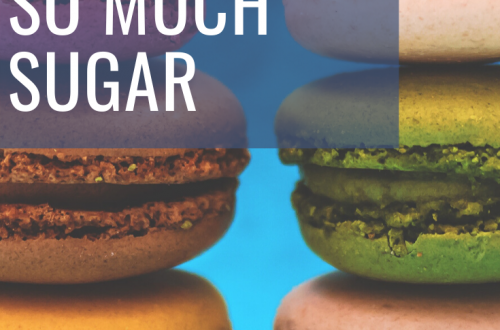
10 Must-Have Foods for Healthy Eating
Ever think about overhauling your diet or just eating healthier, but then get overwhelmed with all the choices? It’s no wonder – the options are endless! The average supermarket now carries over 40,000 products, which is a 5x increase from the 1970s – so many choices [1, 2]!! When I talk about food and nutrition with friends and family, one of the most common questions I get is, “What do you eat?” I think to myself, “Yay – I’m so glad you want to chat about food!” because I could talk for days about it!
Even though I think a lot about food and nutrition, the reality is that I tend to eat the same foods over and over again. I think of these foods as my healthy eating “staples”, and they have two of the following three criteria: they that taste great, offer high nutrition value, and eating them makes me feel good. These are the foods that I could live – and thrive – on, if I had no other options at all. So, although I can choose from >40,000 foods, these 10 are on my plate (almost) every single day.
Below are my top ten must-have foods for a healthy diet, along with the scientific and (let’s face it) psychological reasons they are my foods. They are loosely listed in order of consumption throughout the day, ie, breakfast through dinner:
1. Plain whole milk yogurt
Rich and creamy, whole milk yogurt (especially the Greek variety) is high in protein, fat, and contains no added sugar.
- Non-skimmed dairy is good for you. Full-fat dairy foods used to be avoided due to their saturated fat content. However, recent research indicates that people who eat more dairy products, especially those that are whole milk, no-sugar-added varieties, have lower risk of heart disease and tend to live longer [3, 4].
- No added sugar and lower in lactose. We all know eating less sugar is better for our bodies, but full-fat dairy products take this one step further. A recent study found that dairy fat biomarkers (ie, compounds in the blood of people that eat dairy fat) are associated with a >40% reduced risk in developing Type II diabetes [5, 6].
- It tastes sooo good. Have you ever tried nonfat vs full-fat yogurt side-by-side? If you have, you know what I’m talking about – chalky and thin vs creamy and thick.
2. Bananas
Mellow and sweet, bananas are perfect for livening up a breakfast bowl and making smoothies creamy.
- Nutrient dense and calorie light. The typical Cavendish banana we find at the supermarket contains only 100 calories. Bananas are also relatively high in fiber and contain many vitamins and minerals, especially vitamin B6 (33%) and manganese (14%). Note that while bananas are known for their high potassium value, most other fruits and veggies have plenty of potassium, too [7].
- Digestive health benefits. Unripe bananas, or ones that have more digestive-resistant starch and pectin and less sugar content, can help you feel full and improve insulin sensitivity [8].
- Easy and delicious. Bananas are one of the most available and convenient foods, and are super simple add-ins to cereal, yogurt, and baked goods recipes. Ripe bananas are a great way to satisfy a sweet tooth without going overboard on, say, chocolate cake.
3. Cinnamon
The sweet heat of cinnamon spice livens up no-sugar-added breakfasts and snacks.
- Antioxidant-rich. Cinnamon is high in polyphenols, a type of antioxidant, which, like all antioxidants, helps to protect cells from damage [9].
- A proven flavor enhancer. Did you know that the bark of the cinnamon tree has been used for thousands of years as a spice and in traditional medicine?! Personally, I just love the taste of cinnamon, and probably use too much. The recommended daily maximum is ½ – 1 teaspoon a day [10].
4. Coffee
The magical elixir of my morning.
- Possible health benefits. Recent studies have found that moderate consumption of coffee (3 – 4 cups/day – woohoo!) is associated with longer lifespan and reduced risk from several chronic diseases [11].
- Something yummy to drink – not water. The take-home here is that I love having options for unsweetened, non-water drinks. If you hate coffee, go for your favorite tea or sparkling water. The objective here is to enjoy what you drink.
5. Dark, leafy greens (DLG)
It’s no secret that DLGs are superfoods … but also tasty.
- Nutritional powerhouses: Kale, spinach, mustard and collard greens – they are all packed with vitamins, minerals, fiber, and antioxidants, all while being super low in calories.
- Versatile: DLGs can be served cooked or raw, used as a wrap or chopped in a salad or stir-fry, and are a great carrier for any savory flavoring [12]. The options are endless!
6. Cauliflower, Broccoli, or Winter Squash
Delicious, high-nutrition value veggies
- Nutritionally superior to starches. These delicious vegetables are full of fiber, vitamins and minerals. Plus, they can easily be used in place of higher-carbohydrate, lower-nutrient foods like rice, pasta, and potatoes [13].
- So many uses! Any of these veggies can be roasted, fried, chopped or pureed. I know there’s a lot of attention on cauliflower rice, but I wholeheartedly encourage more creative (and easier) veggie endeavors. My personal favorite is roasting – here’s how I roast broccoli (or any veggie, for that matter).
7. Eggs
Delicious, versatile, and oh, so nutritious.
- Punching above their nutritional weight. At only 75 calories, a single egg provides 5-6 grams of protein, 5 grams of healthy fat, and 0 grams of carbs. Not only that, you’ll get a decent amount of several B vitamins and various minerals.
- Eggs do not raise blood cholesterol for most people. Despite the historical warnings that dietary cholesterol would cause us all to have heart attacks, more recent and thorough research has dismissed this. Egg on!
- Delicious, versatile, inexpensive. Eggs for breakfast (over easy), lunch (on a salad) and dinner (frittata) – they can be for any meal! Even if you buy the fanciest, organic-est eggs around, one dozen large eggs (~1.25 lb) will still cost less than a pound of equivalent-quality meat or fish.
8. Extra Virgin Olive Oil (EVOO)
The king of fats
- “Extra virgin” only please. “Extra virgin” olive oil is an unrefined oil, meaning it is not treated with chemicals or altered with heat. Lower quality olive oils (non-EVOOs) can be extracted using chemical solvents and/or heat, or mixed with cheaper oils. Both of these processes reduce the benefits of EVOO by destroying antioxidants and possibly introducing harmful chemicals and free radicals. Be sure to read your labels!
- Antioxidants and anti-inflammatory. EVOO is loaded with cell-protecting antioxidants (like oleocanthal) that reduce chronic inflammation, which is linked to many diseases such as cardiovascular disease, cancer, arthritis, and others.
- Multi-purpose – Cook or dress with it. Because EVOO contains mostly monounsaturated fatty acids, it is fairly heat-damage resistant and safe for cooking [14]. EVOO is a perfect dressing base or drizzle for salads, sides, and main dishes. The easiest salad dressing ever goes like this: 3-2-1 ratio of EVOO, balsamic vinegar, and mustard; plus pinch of salt.
9. Salt and pepper
Essential seasoning. There’s really not a lot to say except that a pinch of salt makes anything taste better (even sweets – believe me!). Pepper naturally goes with salt and livens up anything savory.
10. Mustard
A go-to condiment for (almost) any occasion.
- Emergency flavor. Ever find yourself with a salad and no dressing? Or an under-seasoned vegetable or meat dish? I have – it’s called “condiment insecurity”, and mustard is my solution. It can be the free packets of straight yellow from 7-Eleven or the fancy whole-grain type at a restaurant – I’ll take what I can get. Mustard is a low-calorie, high-flavor way to flavor or moisten up anything savory.
- Nutritionally superior to packaged dressings. Most widely available salad dressings contain added sugar, preservatives, and are made with soybean oil, (which is cheaper and more shelf stable than, say, EVOO) [15]. While none of these things are harmful in small amounts, if you are trying to avoid them altogether – go for that mustard!
OK, that’s the top 10 list of my must-have foods for a healthy diet. A couple caveats or disclaimers:
- These are the foods that work for me. They might not all work for you, and that’s OK. For example, if you have an egg allergy, eggs are definitely not one of your foods! Maybe you go for chicken, tuna, or even beans instead.
- I admit that some of the items on this list (coffee, salt and pepper) are not “food” in the traditional sense. However, I include them here as part of a “if I could only eat or drink ten items and be healthy” mentality. Sure, salt and pepper are not nutritional superfoods, but they sure do make DLG, cauliflower, and eggs super tasty.
- Health benefits listed here are not all-inclusive. For example, I realize I didn’t say anything about the pro-biotic characteristics of yogurt! Look for a future post on that.
Let me tell you quickly why I continually choose these foods (aside from the nutritional and psychological reasons already listed):
With only a few of the items on my go-to list, I can create many simple, fast, and super healthy meals.
Examples:
- Dark greens sauteed in olive oil with fried eggs. Season with salt and pepper.
- Sliced banana with cinnamon and full-fat yogurt. Enjoy with coffee.
- Salad of raw greens, chopped cauliflower, hard-boiled eggs. Dressed with mixture of EVOO, mustard, and salt and pepper.
Whether you’re looking for a single healthy food to add to your plate, or want to clean out your pantry and start from scratch, I hope that one or more of these foods will work for you!
I’d love to hear your feedback! What are your go-to health foods? Do you think you could eat only 10 foods? What would they be? Also, if you try eating only these foods, let me know how it goes!
References
- “Supermarket Facts.” FMI, www.fmi.org/our-research/supermarket-facts.
- “Supermarket Product Choices – Consumer Reports Magazine.” Supermarket Product Choices – Consumer Reports Magazine, www.consumerreports.org/cro/magazine/2014/03/too-many-product-choices-in-supermarkets/index.htm.
- Dehghan, Mahshid, et al. “Association of Dairy Intake with Cardiovascular Disease and Mortality in 21 Countries from Five Continents (PURE): a Prospective Cohort Study.” The Lancet, vol. 392, no. 10161, 2018, pp. 2288–2297., doi:10.1016/s0140-6736(18)31812-9.
- Rice, Beth H. “Dairy and Cardiovascular Disease: A Review of Recent Observational Research.” Current Nutrition Reports, Springer US, 15 Mar. 2014, www.ncbi.nlm.nih.gov/pmc/articles/PMC4006120/.
- Ducharme, Jamie. “Why Whole-Fat Milk and Yogurt Are Healthier Than You Think.” Time, Time, 11 Sept. 2018, time.com/5391756/dairy-whole-fat-milk-yogurt/.
- Yakoob, Mohammad Y., et al. “Circulating Biomarkers of Dairy Fat and Risk of Incident Diabetes Mellitus Among Men and Women in the United States in Two Large Prospective Cohorts.” Circulation, vol. 133, no. 17, 2016, pp. 1645–1654., doi:10.1161/circulationaha.115.018410.
- “Banana.” Wikipedia, Wikimedia Foundation, 27 Oct. 2019, en.wikipedia.org/wiki/Banana#Nutrition.
- Bjarnadottir, Adda. “11 Evidence-Based Health Benefits of Bananas.” Healthline, Healthline Media, 18 Oct. 2018, www.healthline.com/nutrition/11-proven-benefits-of-bananas#section8.
- “Antioxidants: Health Benefits and Nutritional Information.” Medical News Today, MediLexicon International, 29 May 2018, www.medicalnewstoday.com/articles/301506.php.
- Raman, Ryan. “6 Side Effects of Too Much Cinnamon.” Healthline, Healthline Media, 26 Sept. 2019, www.healthline.com/nutrition/side-effects-of-cinnamon#1.
- Shmerling, Robert H. “The Latest Scoop on the Health Benefits of Coffee.” Harvard Health Blog, 25 Sept. 2017, www.health.harvard.edu/blog/the-latest-scoop-on-the-health-benefits-of-coffee-2017092512429.
- Dark Green Leafy Vegetables : USDA ARS, www.ars.usda.gov/plains-area/gfnd/gfhnrc/docs/news-2013/dark-green-leafy-vegetables.
- Elliott, Brianna. “The Top 8 Health Benefits of Cauliflower.” Healthline, Healthline Media, 14 Apr. 2017, www.healthline.com/nutrition/benefits-of-cauliflower#section2.
- Gunnars, Kris. “Why Extra Virgin Olive Oil Is The Healthiest Fat on Earth.” Healthline, Healthline Media, 25 Oct. 2019, www.healthline.com/nutrition/extra-virgin-olive-oil#cooking.
- Harvard Health Publishing. “Choosing Oils for Cooking: A Host of Heart-Healthy Options.” Harvard Health, www.health.harvard.edu/heart-health/choosing-oils-for-cooking-a-host-of-heart-healthy-options.






5 Comments
Pingback:
Morgan
I like to cook large batches of chicken breasts in my Instant Pot to have throughout the week. They make great lunches on top of DLG and can be stir fried with on-hand veggies for a quick dinner. I can relate to condiment insecurity, my go-to is homemade, stevia-sweetened ketchup. Yum! Now, for another cup of coffee…
HealthNut
Great tips, thanks! I tend to avoid bananas because they are high in carbs – any suggested alternatives?
Brook Hagen
Hi there! Berries are lower carb fruits and also freeze/blend well. I like strawberries and blueberries myself. 🙂
Morgan
Nice list. I like to cook family packages of versatile chicken breasts in the Instant Pot for lunch salads (on DLG of course!) and, on occasion, to chop and stir fry in a skillet with veggies for dinner in a pinch. And I can definitely relate to condiment insecurity. My go-to is homemade stevia-sweetened ketchup!